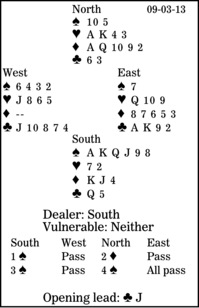Bridge column, September 3: When it looks bad, be an optimist

At the bridge table, players tend to be optimists or pessimists. In this deal, for example, look at the East and North hands. East is defending against four spades. West leads the club jack. What should East do?
In Standard American, South's three-spade rebid shows extra values (usually 15-17 high-card points) and a good six-card suit. It is game-forcing after North's two-over-one response. If you are using two-over-one game-force, then three spades promises a solid suit and sets it as trumps. The responder is asked to control-bid (cue-bid) if interested in a slam. Here, North has a borderline hand. He could justify a four-diamond or four-heart control-bid. But since South has no side first-round control, he would sign off in four spades.
The dummy is depressing. East knows that if declarer needs a diamond finesse, it is working. East can see two club winners. Maybe West has a trump trick (but not if South has shown a solid suit). What other chance is there?
None, apparently.
Well, there is one -- West might be void of diamonds. After winning with his club king, East should shift to a diamond.
Here, West ruffs, returns a club to East's ace, and receives another ruff for down one. Houseflies, be gone!
Some players would find this ruff, but only at trick three. They cannot resist immediately cashing available tricks. Take your time and think through the deal.
** ** **
COPYRIGHT: 2013, UNITED FEATURE SYNDICATE
DISTRIBUTED BY UNIVERSAL UCLICK FOR UFS

